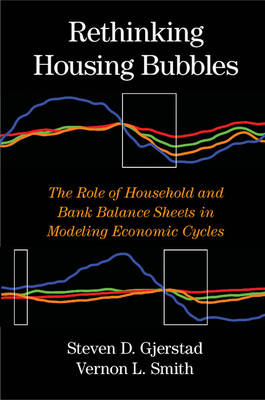
Rethinking Housing Bubbles
Cambridge University Press (Verlag)
978-0-521-19809-7 (ISBN)
In this highly original piece of work, Steven D. Gjerstad and Nobel Laureate Vernon L. Smith analyze the role of housing and its associated mortgage financing as a key element of economic cycles. The authors combine data from both laboratory and real markets to provide insight into the bubble propensity of real-world economic actors and use novel historical analysis on the Great Recession, the Great Depression, and all of the post-World War II recessions to establish the critical roles of housing, private-capital investment, and household and private institutional balance sheets in economic cycles. They develop a model that incorporates household balance sheets and bank balance sheets and offers insights based on this analysis concerning policy going forward, effectively changing the way economists think about economic cycles.
Steven D. Gjerstad is a presidential Fellow at Chapman University in Orange, California. After receiving his PhD in economics from the University of Minnesota, he worked for ten years on theoretical and computational models of market price adjustment processes and on experimental tests of those models. His work on price adjustment has appeared in Economic Theory, Games and Economic Behavior, and the Journal of Economic Dynamics and Control. In the past five years, the emphasis of his work has shifted toward an examination of adjustment processes in the aggregate economy, with an emphasis on financial crises and economic restructuring. That work has been published in the Wall Street Journal, the Critical Review, The American Interest magazine, and the Cato Journal, as well as by the National Bureau of Economic Research. Vernon L. Smith was awarded the Nobel Prize in Economic Sciences in 2002 for his groundbreaking work in experimental economics. He has joint appointments in the Argyros School of Business and Economics and the School of Law at Chapman University, and he is part of a team that will create and run the new Economic Science Institute there. Dr Smith has authored or co-authored more than 250 articles and books on capital theory, finance, natural resource economics, and experimental economics. He serves or has served on the board of editors of the American Economic Review, the Cato Journal, the Journal of Economic Behavior and Organization, the Journal of Risk and Uncertainty, Science, Economic Theory, Economic Design, Games and Economic Behavior, and the Journal of Economic Methodology. He is a past president of the Public Choice Society, the Economic Science Association, the Western Economic Association, and the Association for Private Enterprise Education. He received his PhD from Harvard University.
1. Economic crises, economic policy, and economic analysis; 2. Goods and service markets vs. asset markets; 3. Asset performance: housing and the Great Recession; 4. The Great Depression; 5. The postwar recessions; 6. What may have triggered or sustained the housing bubble, 1997–2006?; 7. The bubble bursts: subprime mortgages, derivatives, and banking collapse; 8. Blindsided experts; 9. What might be done?; 10. Learning from foreign economic crises: consequences, responses, and policies; 11. Summarizing: what have we learned?
| Zusatzinfo | 10 Tables, unspecified; 2 Halftones, unspecified; 50 Line drawings, unspecified |
|---|---|
| Verlagsort | Cambridge |
| Sprache | englisch |
| Maße | 157 x 235 mm |
| Gewicht | 540 g |
| Themenwelt | Mathematik / Informatik ► Mathematik ► Angewandte Mathematik |
| Mathematik / Informatik ► Mathematik ► Finanz- / Wirtschaftsmathematik | |
| Wirtschaft ► Allgemeines / Lexika | |
| Wirtschaft ► Volkswirtschaftslehre ► Finanzwissenschaft | |
| Wirtschaft ► Volkswirtschaftslehre ► Makroökonomie | |
| Wirtschaft ► Volkswirtschaftslehre ► Mikroökonomie | |
| ISBN-10 | 0-521-19809-7 / 0521198097 |
| ISBN-13 | 978-0-521-19809-7 / 9780521198097 |
| Zustand | Neuware |
| Haben Sie eine Frage zum Produkt? |
aus dem Bereich


